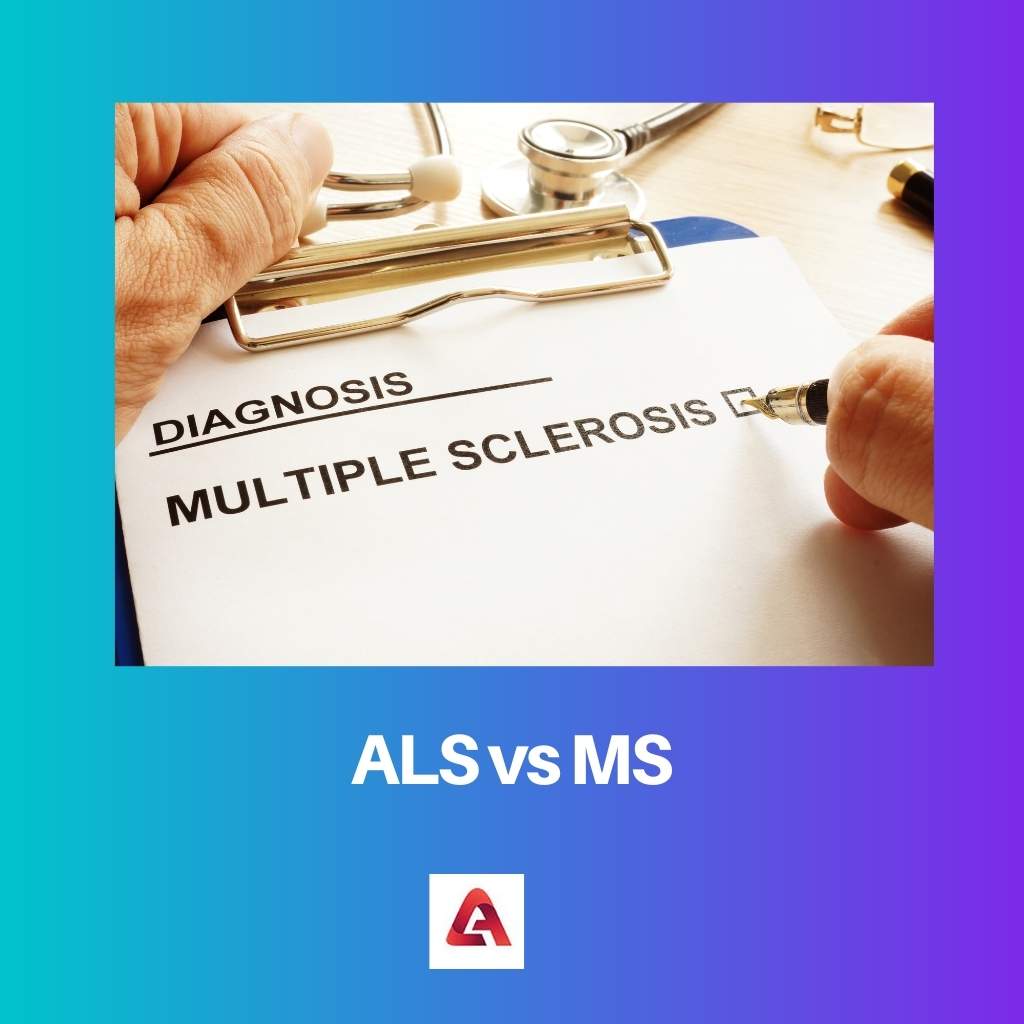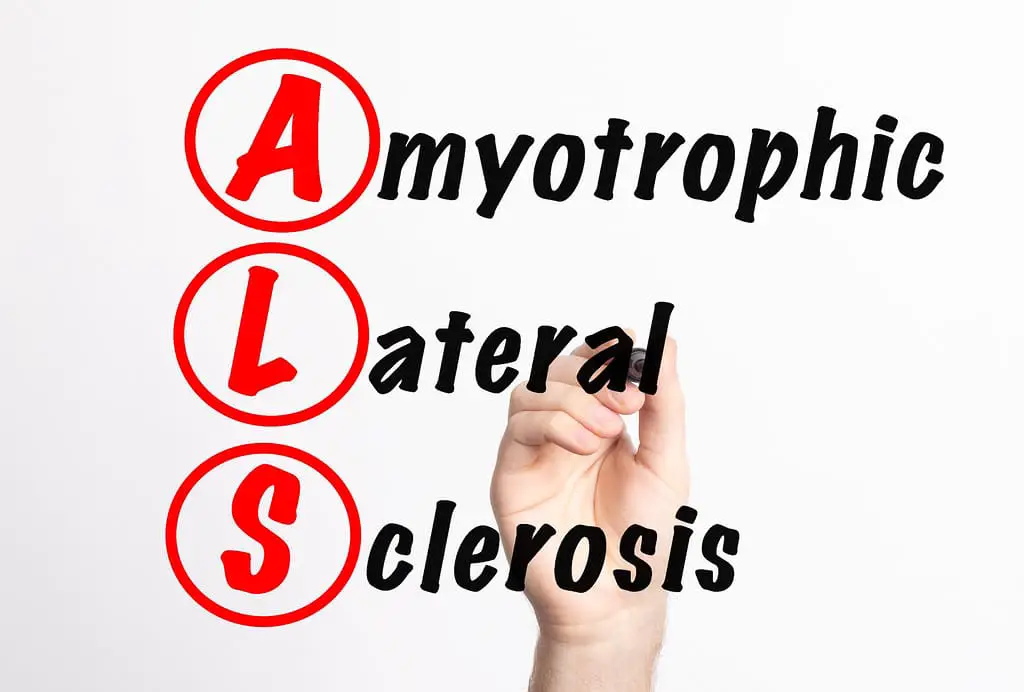The terms ALS (amyotrophic lateral sclerosis) and MS (multiple sclerosis) are interchanged (multiple sclerosis). Both of these illnesses affect and target the central nervous system of the patient.
People with ALS and MS are more likely to have cognitive (knowing and perceiving) and memory problems. Patients with MS are more likely to develop mental disorders than patients with ALS. The most common symptom of ALS is a loss of physical skills.
Key Takeaways
- ALS affects the neurons that control voluntary muscles, whereas MS damages the myelin sheath that covers nerve fibers.
- In ALS, the symptoms start with muscle weakness or stiffness, whereas in MS, symptoms vary and can include blurred vision, numbness, and tingling.
- ALS is more likely to affect people over the age of 50, while MS is more common in people aged 20-40.
ALS vs MS
ALS stands for Amyotrophic Lateral Sclerosis, which affects people aged 50-60, while MS, which stands for Multiple Sclerosis, affects people aged 20-40. In ALS, the patient has sensory loss and no loss of cognitive dysfunction, while in MS, patients have sensory loss and cognitive dysfunction.

Lou Gehrig’s disease, commonly known as ALS, is a chronic, degenerative illness. It affects the nervous system’s motor neurons, which are situated near the spinal cord.
Motor neurons transmit messages throughout the body in a healthy body, instructing muscles and body systems to function. ALS will quickly kill these neurons, preventing them from functioning normally.
MS is a central nervous system (CNS) disease that affects the brain and spinal cord. The protective layer of the central nervous system is destroyed. The transmission of information from the brain to the body is slowed, making motor activities difficult.
It also delays the transmission of sensory information to the brain, decreasing feeling. MS is rarely fatal or completely incapacitated.
Comparison Table
| Parameters of Comparison | ALS | MS |
|---|---|---|
| Common | In Men. | In Female. |
| Targets | The central nervous system and brain. | Spinal cord and the brain. |
| Suffers | Patients have greater physical difficulties and issues. | Patients with MS have greater mental issues and challenges than those of Als. |
| Diagnosed | ages of 40 and 70. | ages of 20 and 50. |
| Late-Stage | Patients who are in the late stages of this illness are paralyzed. | Individuals in the late stages of this disease may have movement issues, although they are unlikely to become totally disabled. |
What is ALS?
ALS is a disease that damages motor neurons and progresses quickly, with symptoms that become worse with time. The illness is marked by the loss of real motor neurons in the spinal cord, resulting in weakness and degeneration in the arms, legs, mouth, and throat.
Nerve cells that have died can no longer transmit impulses to the muscles. Secondary atrophy (Amyotrophy) of the muscles regulated by these cells occurs as a consequence of this.
The condition is known as “lateral sclerosis” because of the hardness of the lateral columns of the spine. Although both sides of the body are affected by ALS, atrophy may begin on one side and become symmetrical as the illness advances.
The person’s intelligent thinking, vision, hearing, or sensations of taste, smell, or touch are unaffected by ALS. It has little impact on sexual, bowel, or bladder functions.
There is no cure for ALS and no effective therapy to slow or halt the disease’s development. ALS eventually kills all of the neurons in the brain. When this occurs, the body stops responding to brain instructions, and people with late-stage ALS become paralyzed.

What is MS?
Multiple sclerosis (MS) is a brain and spinal cord illness that may be debilitating (central nervous system). The protective coating (myelin) that surrounds nerve fibres is attacked by the immune system in MS, causing communication difficulties between the brain and the rest of the body.
The illness may eventually cause irreversible nerve injury or degeneration. The amount of nerve damage and which nerves are damaged determines the signs and symptoms of MS.
Some individuals with severe MS lose their ability to walk independently or at all, while others go into remission for extended periods of time without experiencing any new symptoms.
Multiple sclerosis has no known cure. Treatments, on the other hand, may help patients recover faster from attacks, change the course of the illness, and control symptoms. The majority of people with MS have relapsing-remitting symptoms.
They have relapses or periods of new symptoms that last days or weeks and then recover partly or fully. SucceedingAfter these recurrences, the quiet period of disease remission may last for months or even years.
Small rises in body temperature may exacerbate MS symptoms for a short time, but they aren’t genuine disease relapses. Within 10 to 20 years of the illness start, at least half of people with relapsing-remitting MS have a continuous progression of symptoms, with or without periods of remission. Secondary-progressive MS is the name for this kind of MS.
Main Differences Between ALS and MS
- ALS is most common in males, whereas MS is common in females.
- In ALS, the target is the central nervous system and brain, whereas in MS, the target is the spinal cord and the brain.
- Patients have greater physical difficulties and issues with ALS, whereas patients with MS have greater mental issues and challenges than those with ALS.
- ALS disease is most identified in people between the ages of 40 and 70, whereas MS disease is most identified in people between the ages of 20 and 50.
- Patients who are in the late stages of ALS illness are paralyzed, whereas a person in the late stages of MS may have movement issues, although they are unlikely to become totally disabled.

- https://www.sciencedirect.com/science/article/pii/S0003267017305573
- https://link.springer.com/article/10.1007/s00216-015-9042-2

ALS and MS have different targets. ALS affects the central nervous system and brain, while MS targets the spinal cord and the brain. The age of diagnosis for patients with these illnesses also varies.
You’re absolutely right. The targets, symptoms, and critical age groups are distinguishing features of these neurological conditions.
ALS and MS are two disorders that affect the central nervous system, but they have some differences. ALS impacts neurons that control voluntary muscles, while MS damages the myelin sheath around nerve fibers. Both of them can cause cognitive and memory problems.
Suzanne, you’re right. ALS has a more significant impact on physical skills while MS affects mental disorders more frequently.
It’s fascinating to note that ALS is more likely to affect people over 50, while MS is more common in younger individuals.
The differences between ALS and MS are quite stark, especially in terms of their targets and diagnostic ages. The lack of effective treatments for both illnesses poses significant challenges for patients.
The diagnostic age and the lack of specific treatment options necessitate a proactive approach to patient care. The differences in these neurological conditions require tailored support for patients.
The explanation of ALS and MS in the comparison table is very informative. I appreciate the clear and concise differences highlighted in each parameter.
Lauren, the comprehensive comparison table helps in understanding the distinguishing characteristics of ALS and MS.
I agree. It’s a well-structured comparison that provides a deeper insight into the disparities between these two disorders.
Lou Gehrig’s disease is a chronic and degenerative illness that rapidly affects motor neurons. MS, on the other hand, affects the brain and spinal cord, slowing the transmission of motor and sensory information.
Your explanation is insightful, Megan. ALS and MS have distinct impacts on the nervous system.
Megan, you’ve highlighted the essence of these neurological disorders remarkably well.
MS affects the myelin sheath covering nerve fibers and may lead to irreversible nerve injury and degeneration. The relapsing-remitting nature of this illness makes it unpredictable for patients.
You’ve drawn attention to the progressive and unpredictable nature of MS, Freya. The uncertainty surrounding relapses and remissions can be distressing for patients.
The varying symptoms of MS and its impact on mobility make it a challenging condition to manage. Patients require comprehensive support to navigate through the uncertainties.
ALS primarily affects individuals over 50 and has no cure or effective therapy, ultimately leading to complete paralysis. This is a significant concern for patients diagnosed with ALS.
Indeed, ALS has profound consequences. The absence of a cure and the fatal nature of the illness are distressing for patients and their loved ones.
ALS and MS manifest differently. While ALS starts with muscle weakness and stiffness, MS symptoms are variable and include blurred vision, numbness, and tingling.
That’s correct. It’s also interesting that ALS affects men more, whereas MS is more common in women.
ALS results in the loss of motor neurons in the spinal cord, leading to weakness and degeneration in the arms, legs, mouth, and throat. It’s a debilitating condition with no known cure.
It’s a devastating illness indeed, Joshua. The impact on the patient’s motor functions is profound.
The degenerative nature of ALS significantly affects the patient’s quality of life. It’s a challenging diagnosis to cope with for patients and their families.
The adverse effects of ALS are indeed severe and can lead to paralysis. In contrast, individuals with MS may face movement issues but are less likely to become completely disabled.
You’ve accurately reflected the outcomes of ALS and MS. The severity of ALS is a major concern for patients and their families.